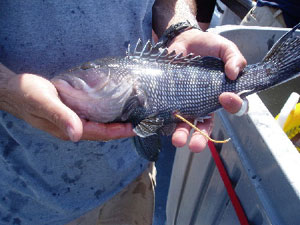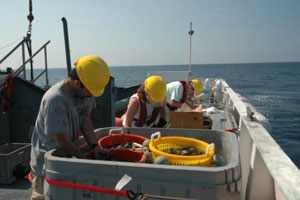| Friday,
May 13, 2005
Good
afternoon, everyone. Boy, today has been a busy day both
on the ship and off. We’ve lost one team member
and gained three others; Daniela left the ship to attend
a conference in Vancouver, British Columbia, so Kate will
be alone collecting acoustic and CTD data. Sarah Goldman
from SC Department of Natural Resources has taken Daniela’s
bunk. She will assist Athan in deploying and recovering
the chevron traps. Kevin Grant also boarded the R/V Nancy
Foster for the first time. He is a fellow with the National
Sea Grant Program and works with the National Marine Sanctuary’s
Headquarters in Silver Spring, MD.
The day started with dives to the sandy and densely colonized
habitat. The latter was full of “stinker”
sponges and other sponges, as well as colonial tunicates.
Don’t miss the amazing picture that Chris took during
one dive to the densely colonized hard bottom habitat.
Another diver, Dave, mentioned seeing a seahorse during
one of his dives. Also, an observation of an illusive
and unidentifiable pipefish is a rumor around the dry
lab.
Today
was quite different from the others; it is the first day
for chevron trap deployment. To prepare for this survey,
Athan is in charge of selecting sites, baiting the traps,
preparing the measurement and degassing stations, and
debriefing other team members (i.e., Sarah, Kate, and
me) to assist with each step. Obviously, Athan cannot
do all of the work for this survey alone so he debriefs
us about the logistics in order to run efficiently and
smoothly.
To
prepare the traps, Sarah and Athan hang four bait stringers
in each trap. Four menhaden dangle from the stringers
in order to 1) simulate a school of fish, and 2) produce
an odor to attract a variety of fish species. In addition,
a couple extra menhaden are thrown into the bottom of
the trap for luck. (It is Friday the 13th so we need all
the good luck we can get.) Three traps are deployed 30
minutes apart from one another and will soak in the water
for 90 minutes each.
 The
recovery of the traps creates an exciting time on the
ship because, unlike the diving surveys, everyone has
a chance to observe the life teeming underneath us. Once
the trap is on deck, Athan, Kate, and I categorize the
fish by species . This was a pretty easy process today
because we only collected two distinctly different species
of fish: black seabass and scup (also known as long spine
porgy). However, we were shocked to find the first two
traps contained 10 black seabass (picture
to left) which had been tagged on a previous expedition
in October 2004 to assess abundance and growth parameters. The
recovery of the traps creates an exciting time on the
ship because, unlike the diving surveys, everyone has
a chance to observe the life teeming underneath us. Once
the trap is on deck, Athan, Kate, and I categorize the
fish by species . This was a pretty easy process today
because we only collected two distinctly different species
of fish: black seabass and scup (also known as long spine
porgy). However, we were shocked to find the first two
traps contained 10 black seabass (picture
to left) which had been tagged on a previous expedition
in October 2004 to assess abundance and growth parameters.
Once the fish were separated, Athan and Sarah worked hard
to remove excess air trapped in the swim bladder of the
fish. The air pressure at the water’s surface is
much lower than that of the deep ocean, so the air in
the fish’s swim bladder expands as it is brought
up to the surface without having time to escape, as it
would under natural vertical migrations in the water column
. Unless our team releases the air by using a sharp needle
to poke through the fish's scales and into the swim bladder,
the fish will not be able to swim down into the water
column once they are released. As a result, the fish will
float to the water's surface and most likely become a
meal for some other hungry fish.
 After
the air is removed, the fish are weighed, measured, and
released. Today, I was in charge of weighing and measuring
the scup and black seabass (picture
to right). My bunkmate, Kate, can attest that it
is a messy and smelly process … but it sure is a
lot of fun! Sarah Fangman mentioned that she loves the
smell of fish…you know you are among kindred spirits
after hearing a statement like that! After weighing and
measuring the fish, I relayed the data to Sarah or Kate.
They were responsible for writing down the data on the
sheets and keeping the data organized for Athan when he
returns to the lab in Charleston. After
the air is removed, the fish are weighed, measured, and
released. Today, I was in charge of weighing and measuring
the scup and black seabass (picture
to right). My bunkmate, Kate, can attest that it
is a messy and smelly process … but it sure is a
lot of fun! Sarah Fangman mentioned that she loves the
smell of fish…you know you are among kindred spirits
after hearing a statement like that! After weighing and
measuring the fish, I relayed the data to Sarah or Kate.
They were responsible for writing down the data on the
sheets and keeping the data organized for Athan when he
returns to the lab in Charleston.
As
you can see, each survey takes a concerted effort among
many people aboard the ship. I am very proud to be a member
of this hard working, yet fun-loving team of marine scientists.
I just wish you were here to experience it with me.
If
any of these experiences interests you or raise any questions,
I’d love to hear them. Please email me at scientist10.nancy.foster@noaa.gov.
See
you then,
Elizabeth
P.S. I cannot wait to do it all over again tomorrow!
Gray’s
Reef National Marine Sanctuary:
Daily Connections to Scientific Inquiry & Nature of
Science
Inferences
in Science:
The
science team cannot count, weigh, measure, and identify
every fish in the sanctuary, so we must sub-sample the
area in order to make conclusions about the total fish
population. This is one aspect that makes science different
from other ways of learning about our world. In this process,
scientists use random sampling measures to ensure that
their samples are not biased. We want the samples to be
as accurately characteristic of the sanctuary as possible
and free of prejudice, favoritism, etc. For example, if
we only surveyed the densely colonized hard bottom habitats
to make our inferences about the entire sanctuary, our
conclusion would be far from accurate. This is because
this habitat traditionally yields a greater diversity
and abundance than other habitats in GRNMS. There are
many different habitats within the sanctuary, each being
characterized by variations in fish abundances and diversity.
|







